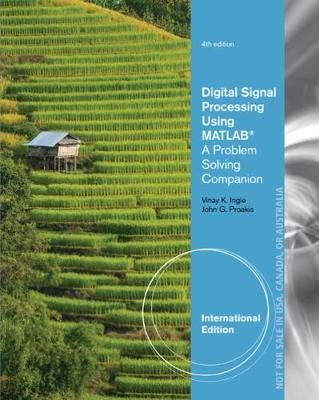
Digital Signal Processing Using MATLAB�
CL Engineering (Verlag)
978-1-305-63753-5 (ISBN)
- Titel ist leider vergriffen;
keine Neuauflage - Artikel merken
Affiliation: University of California, San Diego and Northeastern University Bio: Dr. John Proakis is an Adjunct Professor at the University of California at San Diego and a Professor Emeritus at Northeastern University. He was a faculty member at Northeastern University from 1969 through 1998 and held several academic positions including Professor of Electrical Engineering, Associate Dean of the College of Engineering and Director of the Graduate School of Engineering, and Chairman of the Department of Electrical and Computer Engineering. His professional experience and interests focus in areas of digital communications and digital signal processing. He is co-author of several successful books, including DIGITAL COMMUNICATIONS, 5E (2008), INTRODUCTION TO DIGITAL SIGNAL PROCESSING, 4E (2007); DIGITAL SIGNAL PROCESSING LABORATORY (1991); ADVANCED DIGITAL SIGNAL PROCESSING (1992); DIGITAL PROCESSING OF SPEECH SIGNALS (2000); COMMUNICATION SYSTEMS ENGINEERING, 2E (2002); DIGITAL SIGNAL PROCESSING USING MATLAB V.4, 3E (2010); CONTEMPORARY COMMUNICATION SYSTEMS USING MATLAB, 2E (2004); ALGORITHMS FOR STATISTICAL SIGNAL PROCESSING (2002); FUNDAMENTALS OF COMMUNICATION SYSTEMS (2005). Dr. Vinay K. Ingle is an Associate Professor of Electrical and Computer Engineering at Northeastern University. He received his Ph.D. in electrical and computer engineering from Rensselaer Polytechnic Institute in 1981. He has broad research experience and has taught courses on topics including signal and image processing, stochastic processes, and estimation theory. Dr. Ingle has co-authored numerous higher level books including DSP LABORATORY USING THE ADSP-2181 MICROPROCESSOR (Prentice Hall, 1991), DISCRETE SYSTEMS LABORATORY (Brooks-Cole, 2000), STATISTICAL AND ADAPTIVE SIGNAL PROCESSING (Artech House, 2005), and APPLIED DIGITAL SIGNAL PROCESSING (Cambridge University Press, 2011).
1. INTRODUCTION.
Overview of Digital Signal Processing. A Brief Introduction to MATLAB�. Applications of Digital Signal Processing. Brief Overview of the Book.
2. DISCRETE-TIME SIGNALS AND SYSTEMS.
Discrete-time Signals. Discrete Systems. Convolution. Difference Equations.
3. THE DISCRETE-TIME FOURIER ANALYSIS.
The Discrete-time Fourier Transform (DTFT). The Properties of the DTFT. The Frequency Domain Representation of LTI Systems. Sampling and Reconstruction of Analog Signals.
4. THE z-TRANSFORM.
The Bilateral z-Transform. Important Properties of the z-Transform. Inversion of the z-Transform. System Representation in the z-Domain. Solutions of the Difference Equations.
5. THE DISCRETE FOURIER TRANSFORM.
The Discrete Fourier Series. Sampling and Reconstruction in the z-Domain. The Discrete Fourier Transform. Properties of the Discrete Fourier Transform. Linear Convolution Using the DFT. The Fast Fourier Transform.
6. IMPLEMENTATION OF DISCRETE-TIME FILTERS.
Basic Elements. IIR Filter Structures. FIR Filter Structures. Overview of Finite-Precision Numerical Effects. Representation of Numbers. The Process of Quantization and Error Characterizations. Quantization of Filter Coefficients.
7. FIR FILTER DESIGN.
Preliminaries. Properties of Linear-phase FIR Filters. Window Design Techniques. Optimal Equiripple Design Technique.
8. IIR FILTER DESIGN.
Some Preliminaries. Some Special Filter Types. Characteristics of Prototype Analog Filters. Analog-to-Digital Filter Transformations. Lowpass Filter Design Using MATLAB�. Frequency-band Transformations.
9. SAMPLING RATE CONVERSION.
Introduction. Decimation by a Factor D. Interpolation by a Factor I. Sampling Rate Conversion by a Rational Factor I/D. FIR Filter Designs for Sampling Rate Conversion. FIR Filter Structures for Sampling Rate Conversion.
10. ROUND-OFF EFFECTS IN DIGITAL FILTERS.
Analysis of A/D Quantization Noise. Round-off Effects in IIR Digital Filters. Round-off Effects in FIR Digital Filters.
11. APPLICATIONS IN ADAPTIVE FILTERING.
LMS Algorithm for Coefficient Adjustment. System Identification of System Modeling. Suppression of Narrowband Interference in a Wideband Signal. Adaptive Line Enhancement. Adaptive Channel Equalization.
12. APPLICATIONS IN COMMUNICATIONS
Pulse-Code Modulation. Differential PCM (DPCM). Adaptive PCM and DPCM (ADPCM). Delta Modulation (DM). Linear Predictive Coding (LPC) of Speech. Dual-tone Multifrequency (DTMF) Signals. Binary Digital Communications. Spread-Spectrum Communications.
13. RANDOM PROCESSES
Random Variable, A Pair of Random Variables, Random Signals, Power Spectral Density, Stationary Random processes through LTI Systems, Useful Random Processes.
14. LINEAR PREDICTION AND OPTIMUM LINEAR FILTERS
Innovation Representation of a Stationary Random Processes, Forward and Backward Linear Prediction, Solutions of Normal equations, Properties of Linear Prediction-Error Filters, AR Lattice and ARMA Lattice Filters, Wiener Filters for Filtering and Prediction.
15. ADAPTIVE FILTERS
Applications of Adaptive Filters: System Identification and modeling, Adaptive Channel equalization, Echo cancellation, Suppression of Narrowband Interference in Wideband Signal, Adaptive Line Enhancer, Adaptive Noise Cancelling, Linear Predictive Coding of Speech Signals, Adaptive Arrays, Adaptive Direct Form FIR Filters: The LMS Algorithm, The RLS Algorithm for the Direct Form FIR Filters.
| Erscheinungsdatum | 29.02.2016 |
|---|---|
| Sprache | englisch |
| Maße | 187 x 235 mm |
| Gewicht | 982 g |
| Themenwelt | Mathematik / Informatik ► Informatik |
| Technik | |
| ISBN-10 | 1-305-63753-4 / 1305637534 |
| ISBN-13 | 978-1-305-63753-5 / 9781305637535 |
| Zustand | Neuware |
| Informationen gemäß Produktsicherheitsverordnung (GPSR) | |
| Haben Sie eine Frage zum Produkt? |
aus dem Bereich


